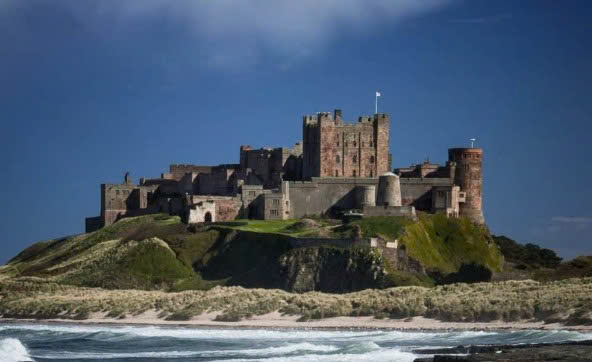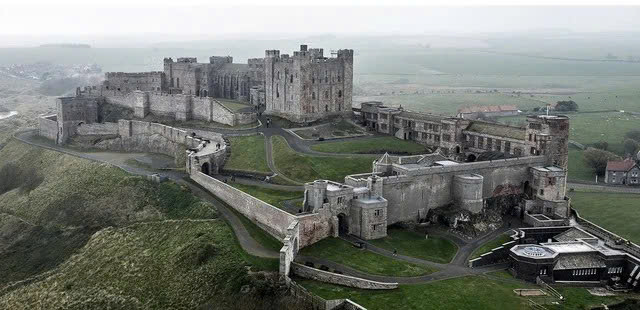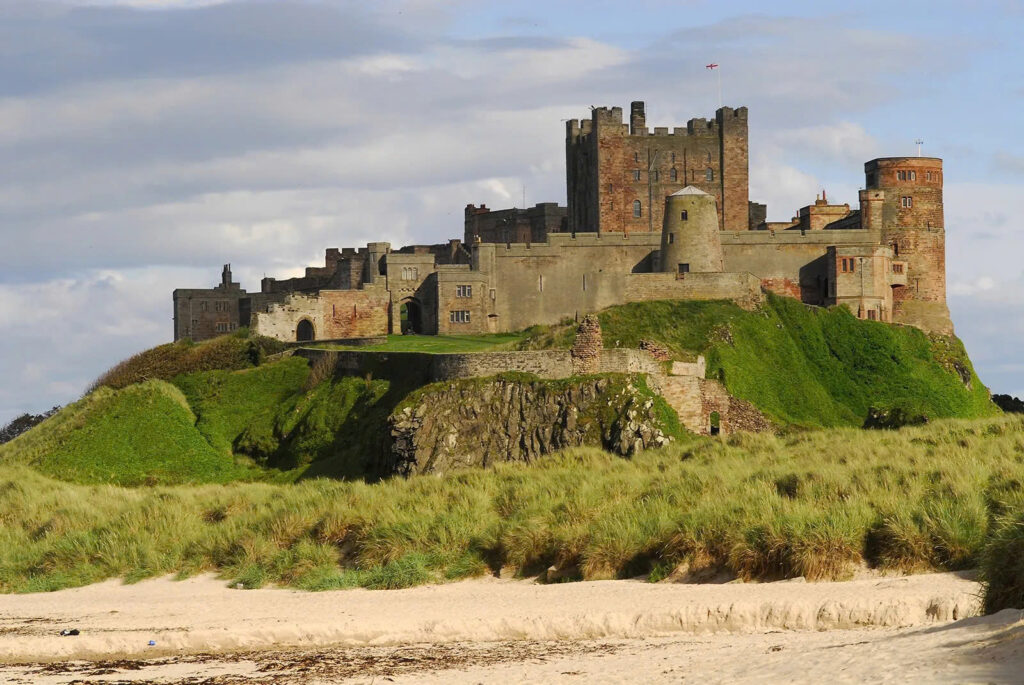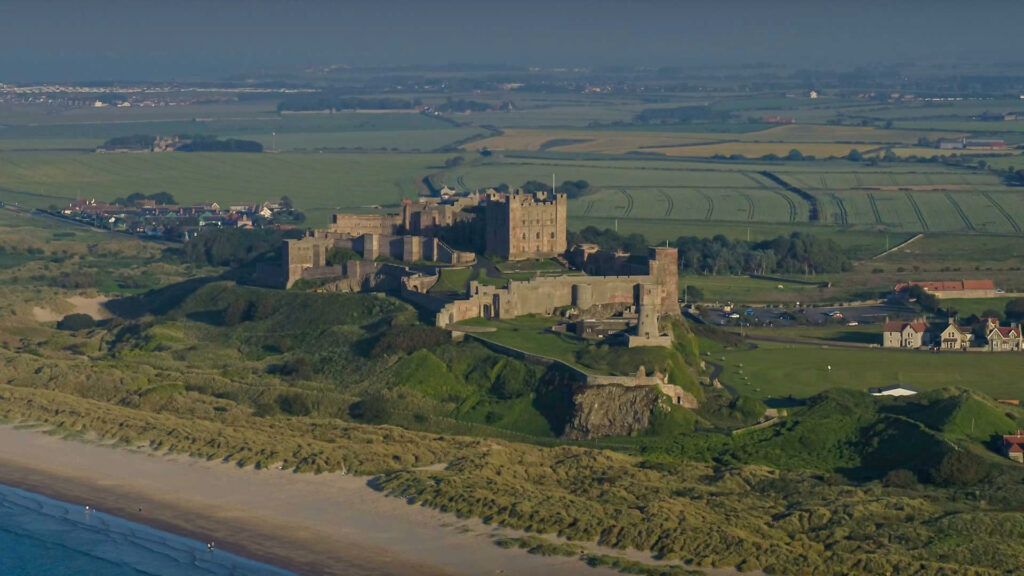Perched majestically on the rugged Northumbrian coastline, Bamburgh Castle stands as one of England’s most enduring fortresses, its weathered stones bearing witness to over fifteen centuries of triumph, tragedy, and transformation. This magnificent stronghold, rising 150 feet above the North Sea on its ancient basalt foundation, has evolved from a Celtic hill fort to a modern-day treasure trove of history and legend.
Ancient Foundations and Royal Beginnings
The story of Bamburgh Castle begins long before the Norman Conquest, rooted in the mists of prehistoric Britain. Archaeological evidence suggests that this commanding position overlooking the Farne Islands and Holy Island of Lindisfarne has been fortified since before Roman times, when Celtic tribes recognized the strategic value of this natural fortress.
The Anglo-Saxon Era

In the 6th century, the site gained prominence under King Ida of Bernicia, who established it as his royal stronghold around 547 AD. The fortress passed to his grandson Aethelfrith, becoming the beating heart of the Northumbrian kingdom. For centuries, it served as a coronation site for Northumbrian monarchs, its great hall echoing with the ceremonies that shaped early English history.
However, the castle’s golden age came to a violent end in 993 when Viking raiders swept down from the sea, leaving destruction in their wake. The Northumbrian dynasty’s grip on power was finally broken, setting the stage for the Norman transformation that would follow.
Medieval Might and Legendary Connections
Norman Reconstruction
Following the Norman Conquest, Bamburgh was rebuilt as a formidable medieval fortress. The castle successfully withstood a siege by William II in 1095, demonstrating the effectiveness of its new Norman fortifications. Under Henry II, who ascended to the English throne in 1154, the castle underwent significant expansion, with the impressive keep completed in 1164 forming the cornerstone of the structure that visitors see today.
Arthurian Legend and Literary Fame
Medieval romance writers wove Bamburgh into the fabric of Arthurian legend, claiming it as the stronghold of Sir Lancelot, the most celebrated knight of the Round Table. While historically inaccurate, these tales cemented the castle’s place in the popular imagination as a symbol of chivalric ideals and knightly virtue.
The Dawn of Modern Warfare

The castle’s military significance came to a dramatic end during the Wars of the Roses in 1464, when it became the first English castle to fall to cannon fire. Edward IV’s artillery bombardment marked not just the end of Bamburgh’s defensive capabilities, but symbolized the twilight of medieval warfare itself. The age of chivalry, so romantically associated with the castle’s legendary connections, had met its match in gunpowder technology.
Decline and Charitable Renaissance
Centuries of Neglect
The 16th and 17th centuries saw Bamburgh Castle slide into gradual decline. Its military importance diminished, the fortress was largely abandoned, its once-proud walls crumbling as nature began to reclaim the ancient stones.
Lord Crewe’s Vision

In 1704, the castle found new purpose when Bishop of Durham Lord Crewe acquired the property. Rather than restore it as a private residence, Crewe transformed Bamburgh into a center of charitable works. The castle housed a free school, a public library, and an infirmary, serving the local community in ways its medieval builders never imagined. Substantial restoration work in the 1750s began to reverse centuries of decay.
Victorian Transformation and Modern Legacy
The Armstrong Era
The castle’s most dramatic transformation came in 1894 when William Armstrong, a prominent engineer and armaments manufacturer, purchased the property. Armstrong’s vision was ambitious: to create a unique blend of medieval fortress and Victorian mansion that would serve as both family home and historical showcase.
Video
Architectural Innovation
Armstrong’s renovation program was extensive and sometimes controversial. While some original structures were demolished, others were carefully restored and enhanced. The crown jewel of his work was the magnificent King’s Hall, featuring an elaborate faux hammer beam ceiling and an extraordinary collection of Fabergé stone animal carvings that reflected the Victorian era’s fascination with craftsmanship and exotic artistry.
Contemporary Cultural Impact
A Living Museum

Today, Bamburgh Castle serves multiple roles as a private residence for Armstrong’s descendants, a public museum, and a cultural landmark. Visitors can explore collections of historical arms, period furniture, intricate tapestries, and fine porcelain that span centuries of British history.
Hollywood’s Medieval Backdrop
The castle’s cinematic appeal has made it a favorite location for filmmakers seeking authentic medieval atmosphere. From the 1964 historical drama “Becket” to the 1971 biographical film “Mary, Queen of Scots,” and most recently the 2023 adventure “Indiana Jones and the Dial of Destiny,” Bamburgh Castle continues to captivate audiences worldwide.
Conclusion: A Castle for All Ages

Bamburgh Castle’s remarkable journey from ancient Celtic hill fort to modern tourist destination illustrates the evolving nature of historical preservation. Each era has left its mark on these ancient stones, creating a unique tapestry of architectural styles, historical periods, and cultural influences. As it stands today, commanding the same dramatic views that have inspired visitors for over a millennium, Bamburgh Castle remains not just a monument to the past, but a living testament to the enduring power of human ambition and imagination.
The castle’s story continues to unfold, welcoming new generations of visitors who come to walk in the footsteps of kings and knights, to stand where legend and history intertwine, and to experience the timeless majesty of one of England’s most spectacular fortresses.

